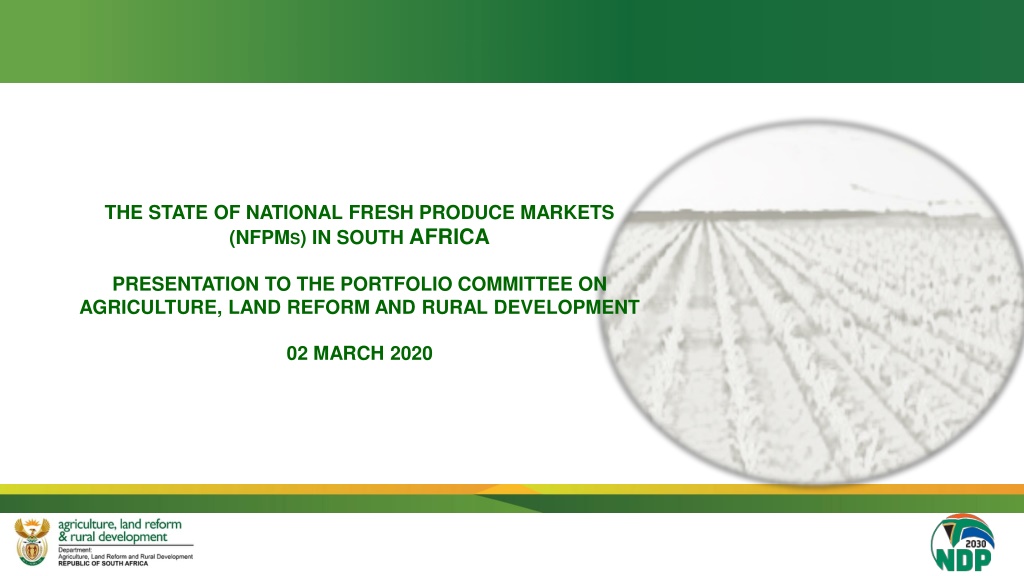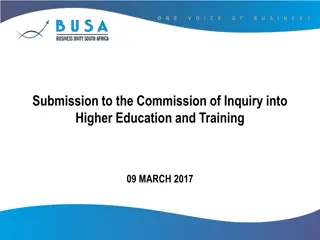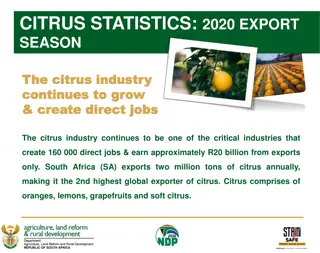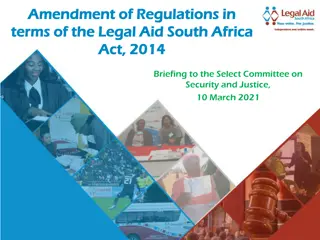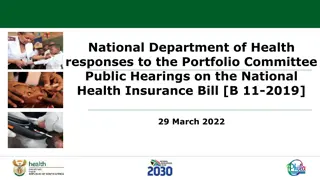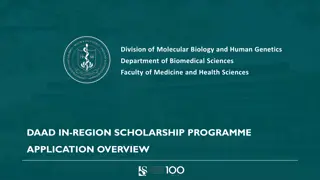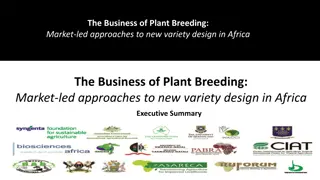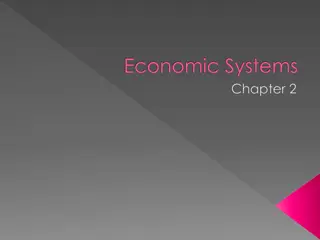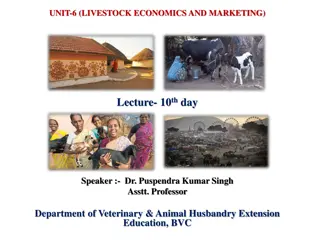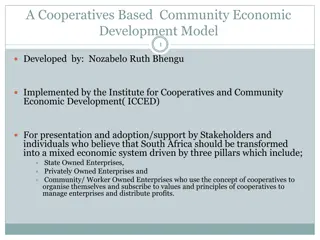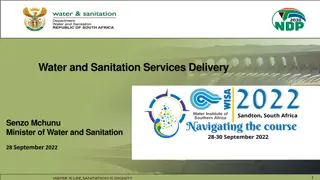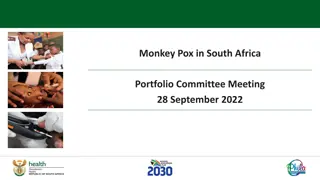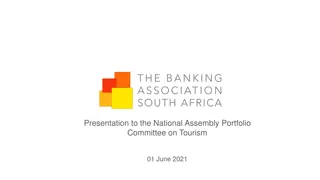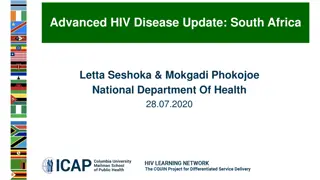The State of National Fresh Produce Markets in South Africa
Presentation to the Portfolio Committee on Agriculture, Land Reform, and Rural Development, highlighting the importance of National Fresh Produce Markets (NFPMs) in South Africa. The presentation covers the challenges, recommendations, and key details such as the number of NFPMs operating, turnover, ownership/management categories, and their role in food security and local economic development.
Download Presentation

Please find below an Image/Link to download the presentation.
The content on the website is provided AS IS for your information and personal use only. It may not be sold, licensed, or shared on other websites without obtaining consent from the author. Download presentation by click this link. If you encounter any issues during the download, it is possible that the publisher has removed the file from their server.
E N D
Presentation Transcript
THE STATE OF NATIONAL FRESH PRODUCE MARKETS (NFPMS) IN SOUTH AFRICA PRESENTATION TO THE PORTFOLIO COMMITTEE ON AGRICULTURE, LAND REFORM AND RURAL DEVELOPMENT 02 MARCH 2020
Table Of Contents List of Acronyms Introduction & background Project Rebirth of NPFMs Codes of Best Practises Challenges Recommendations and Way forward 2
LIST OF ACRONYMS AFASA: APAC: BEE: BCMM: CASP: CBMA: CFO: CoBP: DCOGTA: DALRRD: EPWP: FSA: IMASA: LED: MIC: NAMC: NFPMs: NFPMC: NSC: PPP: PRNSC: PSA: SAUFM: SLA: SMMEs: SOPs: ToR: African Farmers Association of South Africa Agricultural Produce Agents Council Black Economic Empowerment Buffalo City Metropolitan Municipality Comprehensive Agricultural Support Program Council for Black Market Agents Chief Financial Officer Codes of Best Practice Department of Cooperative Governance and Traditional Affairs Department of Agriculture, Land Reform and Rural Development Expanded Public Works Programme Fruit South Africa Institute of Market Agents of South Africa Local Economic Development Ministerial Interim Committee National Agricultural Marketing Council National Fresh Produce Markets National Fresh Produce Market Council National Steering Committee Public Private Partnership Project Rebirth National Steering Committee Potatoes South Africa South African Union of Food Markets Service Level Agreement Small Medium and Micro-sized Enterprises Standard Operating Procedures Terms of Reference 3
Introduction & background Why NFPMs? Public marketing infrastructure key for food security & Local Economic Development (LED): Low-cost marketing channel for farmers; Provide trading facilities for fresh produce industry stakeholders; Outlet where large buyers procure fruits & vegetables; Suppliers to hawkers LED; Price forming mechanism; and Revenue generating asset. 4
Introduction & background 23 NFPMs operate in South Africa NFPMs sold 3.4 million tons of fresh vegetables and fruits with a turnover of R17 billion in 2019. There are four categories of NFPMs in terms of ownership/management, namely Department/business units Corporatised/municipal entities Public private partnerships Privately owned and operated entities 5
Introduction & background Category Municipally owned and operated markets (Department/ business units) Markets Tshwane; Sol Plaatjie (formerly Kimberley); Port Elizabeth; East London; Durban; Mangaung (formerly Bloemfontein); Pietermaritzburg; Matjhabeng (formerly Welkom); Matlosana (formerly Klerksdorp); Springs; Vereeniging and eMalahleni (formerly Witbank) Corporatised/Municipal Entity Joburg and Kei Public private partnerships (municipally owned but privately operated) Cape Town Privately owned and operated George; Nelspruit; Mpumalanga; Mooketsi; Polokwane and Van der Bijl Park 6
Introduction & background How do NFPMs operate? Farmers deliver produce to the market facilities; Sales of fresh produce facilitated by fresh produce market agents; Market agents charge commission fee of 5 7.5% of turnover per sale; and Municipalities charge market fee of 5% on turnover. Farmer incurs 12.5% cost. 7
Project Rebirth of NFPMs Collaborative effort between Government and the fresh produce industry to improve and revive the operations and service standards of NFPMs across the country. Members are producer bodies (Potatoes SA, Fruit SA, DFDC); Agents (IMASA, CBMA); Regulator (APAC), advisory body (NAMC) and Government (DALRRD & DCOGTA) Project Rebirth was established as a result of the following: Declining service standards; Municipalities not reinvesting municipal revenue into markets; Continued physical infrastructure deterioration; Non-conformance to food safety & health standards; Poor management capacity in most markets; ownership/ management; Absence of SOPs; Poor information management systems; Outdated market by-laws; poor compliance & general absence of SLA; Section 7 investigations (1998 2009). 8
Key interventions Approach was adopted by NSC of Project Rebirth to revive the operations and service standards of struggling markets and is in 5 phases: 1st Phase (Diagnostic phase) Meetings with market management and agents to collectively identify challenges hampering the operations of the market thereby leading to a decline in its service standards. 2nd Phase (Implementation phase) Market management and market agents were then afforded an opportunity to implement the recommendations of the diagnostic report over a period of time. 9
Key interventions 3rd Phase (Facilitation of implementation of the Codes) Follow up visits and unannounced visits (on average at least 5 visits per market) undertaken to assess improvements. Summarized reports produced to track progress. Tshwane FPM and Joburg Market expertise solicited to assist. 4th Phase (Utilisation of the scorecard) Scorecard applied in markets where there is improvements in basic services such as hygiene and cleanliness and market management 5th Phase (Municipality engagement) Engagement with municipal officials in markets deteriorating further and market management is incapable of implementing the recommendations of the reports 10
Key interventions Collaboration with municipalities Municipal and public investment onto markets Establishment of Mentorship program Instituted investigation on ethical trading in the NFPMs Promotion of National Fresh Produce Markets Collaboration with DCOGTA Draft Bill on NFPMC 11
Challenges Lack of continuity and stability at market management level ; Majority of municipality unwilling to reinvest a portion of 5% market revenue onto market; Municipalities not recognising the market as their core mandate; Changing the attitudes of some market management and market agents remains a huge challenge; An effective and well organised SAUFM is a key requirement towards the successful implementation of the CoBPs; The ability of market agents and sales persons to uphold ethical trading practices and implement the CoBP; Failure of BEE agencies to survive for longer periods due to lack of product supply from farmers; and Failure to obtain full cooperation by all Municipalities and gazetting of CoBPs under the leadership of DCOGTA. 12
Recommendations and Way forward NSC will continue facilitating the CoBP as well as the Scorecard. NSC will continue intensifying and implementing the mentorship and coaching program. The fresh produce industry stakeholders considers amending the ToR of NSC and configures the NSC representative body DAFF representative of the NSC to communicate with Minister on the possibility and option of gazetting the CoBP as official norms and standards for fresh produce industry. The Department of Health and Department of Labour be further engaged so that they can contribute on matters related to food safety standards as well as occupational health & safety at NFPMs. 13
Recommendations and Way forward SAUFM should normalise and resuscitate its operations so that it can play a pivotal role in leading the process of implementing the CoBPs. Having exhausted all platforms to improve the markets, there is a need by industry stakeholders to engage and sensitise the Minister of DALRRD on the importance of establishing the NFPMC. 14
THANK YOU 15
